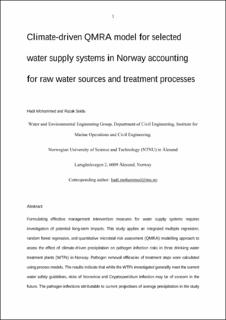| dc.contributor.author | Mohammed, Hadi | |
| dc.contributor.author | Seidu, Razak | |
| dc.date.accessioned | 2020-03-30T14:02:51Z | |
| dc.date.available | 2020-03-30T14:02:51Z | |
| dc.date.created | 2019-01-11T16:51:02Z | |
| dc.date.issued | 2019 | |
| dc.identifier.citation | Science of the Total Environment. 2019, 660 306-320. | en_US |
| dc.identifier.issn | 0048-9697 | |
| dc.identifier.uri | https://hdl.handle.net/11250/2649485 | |
| dc.description.abstract | Formulating effective management intervention measures for water supply systems requires investigation of potential long-term impacts. This study applies an integrated multiple regression, random forest regression, and quantitative microbial risk assessment (QMRA) modelling approach to assess the effect of climate-driven precipitation on pathogen infection risks in three drinking water treatment plants (WTPs) in Norway. Pathogen removal efficacies of treatment steps were calculated using process models. The results indicate that while the WTPs investigated generally meet the current water safety guidelines, risks of Norovirus and Cryptosporidium infection may be of concern in the future. The pathogen infections attributable to current projections of average precipitation in the study locations may be low. However, the pathogen increases in the drinking water sources due to the occurrence of extreme precipitation events in the catchments could substantially increase the risks of pathogen infections. In addition, without optimal operation of the UV disinfection steps in the WTPs, both the present and potential future infection risks could be high. Therefore, the QMRA models demonstrated the need for improved optimization of key treatment steps in the WTPs, as well as implementation of stringent regulations in protecting raw water sources in the country. The variety of models applied and the pathogen: E. coli used in the study introduce some uncertainties in the results, thus, management decisions that will be based on the results should consider these limitations. Nevertheless, the integration of predictive models with QMRA as applied in this study could be a useful method for climate impact assessment in the water supply industry. | en_US |
| dc.language.iso | eng | en_US |
| dc.publisher | Elsevier | en_US |
| dc.rights | Attribution-NonCommercial-NoDerivatives 4.0 Internasjonal | * |
| dc.rights.uri | http://creativecommons.org/licenses/by-nc-nd/4.0/deed.no | * |
| dc.title | Climate-driven QMRA model for selected water supply systems in Norway accounting for raw water sources and treatment processes | en_US |
| dc.type | Peer reviewed | en_US |
| dc.type | Journal article | en_US |
| dc.description.version | acceptedVersion | en_US |
| dc.source.pagenumber | 306-320 | en_US |
| dc.source.volume | 660 | en_US |
| dc.source.journal | Science of the Total Environment | en_US |
| dc.identifier.doi | 10.1016/j.scitotenv.2018.12.460 | |
| dc.identifier.cristin | 1655279 | |
| dc.description.localcode | © 2019. This is the authors’ accepted and refereed manuscript to the article. Locked until 4.1.2021 due to copyright restrictions. This manuscript version is made available under the CC-BY-NC-ND 4.0 license http://creativecommons.org/licenses/by-nc-nd/4.0/ | en_US |
| cristin.unitcode | 194,64,93,0 | |
| cristin.unitname | Institutt for havromsoperasjoner og byggteknikk | |
| cristin.ispublished | true | |
| cristin.fulltext | original | |
| cristin.qualitycode | 2 | |

